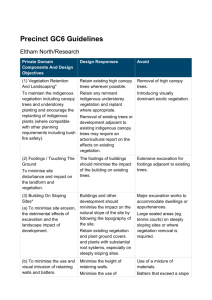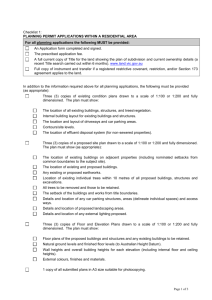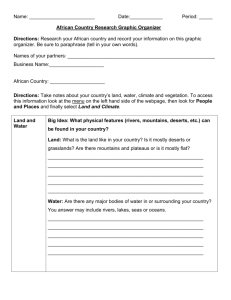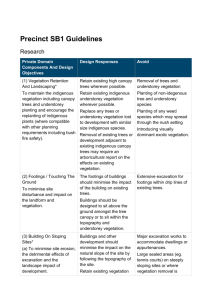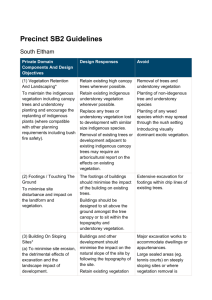Lower Diamond Creek - Nillumbik Shire Council
advertisement
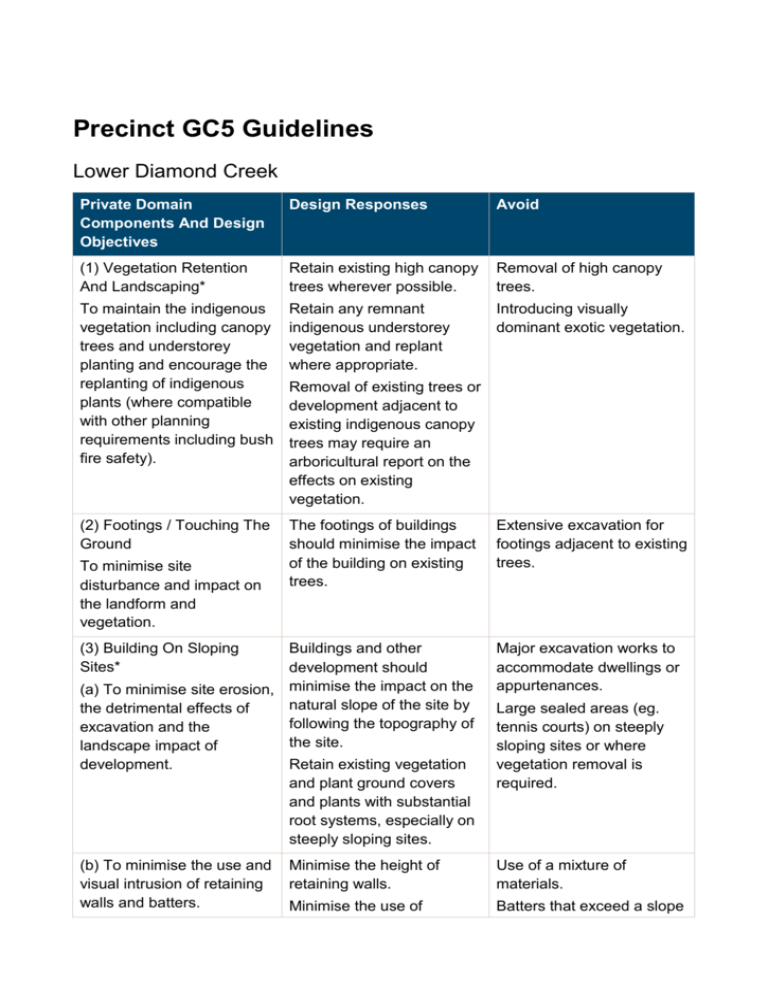
Precinct GC5 Guidelines Lower Diamond Creek Private Domain Components And Design Objectives Design Responses Avoid (1) Vegetation Retention And Landscaping* Retain existing high canopy trees wherever possible. Removal of high canopy trees. To maintain the indigenous vegetation including canopy trees and understorey planting and encourage the replanting of indigenous plants (where compatible with other planning requirements including bush fire safety). Retain any remnant indigenous understorey vegetation and replant where appropriate. Introducing visually dominant exotic vegetation. (2) Footings / Touching The Ground The footings of buildings should minimise the impact of the building on existing trees. To minimise site disturbance and impact on the landform and vegetation. Removal of existing trees or development adjacent to existing indigenous canopy trees may require an arboricultural report on the effects on existing vegetation. (3) Building On Sloping Sites* Extensive excavation for footings adjacent to existing trees. Buildings and other development should (a) To minimise site erosion, minimise the impact on the natural slope of the site by the detrimental effects of following the topography of excavation and the the site. landscape impact of development. Retain existing vegetation and plant ground covers and plants with substantial root systems, especially on steeply sloping sites. Major excavation works to accommodate dwellings or appurtenances. (b) To minimise the use and visual intrusion of retaining walls and batters. Minimise the height of retaining walls. Use of a mixture of materials. Minimise the use of Batters that exceed a slope Large sealed areas (eg. tennis courts) on steeply sloping sites or where vegetation removal is required. Private Domain Components And Design Objectives Design Responses Avoid retaining walls within the side and front setback areas. of 4 to 1. Minimise the area and angle of any batter. Use material in walls and batters that are compatible with the bushland setting. (4) Position On The Site To minimise the visibility of buildings from the road. The front and side setbacks should match the predominant setback and orientation to the street of nearby dwellings. Dwellings or other buildings set further forward of the predominant setback. High retaining walls along the side setback. Insufficient side setbacks that inhibit appropriate landscaping. (5) Height And Building Form To ensure that buildings and extensions do not dominate the streetscape and the wider landscape setting. Design new buildings and extensions so as not to exceed the predominant tree canopy height. Site buildings away from the ridge tops to avoid them being visible on the skyline. (Move to a more appropriate position on the site). Buildings near ridge tops should be positioned and designed so as not to protrude above the ridgeline, when viewed from lower areas. Use simple elevational treatments which complement rather than dominate the bush setting. In areas with fewer trees, match the dominant height Building heights which are out of scale with the neighbouring buildings. Buildings that penetrate the tree canopy. Buildings that protrude above the ridgeline. Private Domain Components And Design Objectives Design Responses Avoid within the street. Where there is a dominance of single storey buildings, the height of the front of the dwelling should match nearby single storey wall heights. (6) Design Detail And Building Materials Use earthy toned finishes or paint colours. Expanses of highly reflective colour or material. Locate carports and garages behind the line of the dwelling or in the rear yard unless this would require significant excavation. Carports and garages forward of the dwelling. Access drives should follow the contours of the site. Significant excavation works. To use materials and building details that harmonise with the bushland setting. 7) Vehicle Access And Storage To minimise excavation for car access, impact on the bush setting and on the visibility of access driveway and car storage facilities. Large areas of hard paving in the front yard. Long, straight driveways and exposed side fences. Locate cars in front of the dwelling only where excavation would be required otherwise. 8) Front Boundary Treatment And Fencing To maintain and enhance the continuous flow of the vegetation and existing landscape. Provide sufficient space in front for the retention and/or planting of large trees and to retain the bush garden. Use timber and rock for retaining walls. Provide no front fencing or side fencing visible from the street. (9) Sustainability And Environmental Factors Orientate buildings to the north. Solid front fences and high retaining walls. Solid side fencing, particularly forward of the dwelling. Large areas of hard paving in the front garden area. Absence of trees or large shrubs in the front garden area. Large west facing windows. Large rainwater collection Private Domain Components And Design Objectives Design Responses Avoid To site and design buildings which maximise the potential for energy conservation and on site water collection, where appropriate. Building forms should maximise the potential for solar heating, solar panel installation and rain water harvesting. tanks on small sites that may be visually intrusive. (11) Construction And Site Management Prepare site works plan showing areas of disturbance, storage of materials and the proposed construction zone. Accumulation of large quantities of building waste on site. To minimise site disturbance and contain building material, construction waste and dust. Contain all building materials and site waste. Minimise disturbance to existing vegetation and topsoil with construction, storage of materials and overburden Protect trees by fencing to the drip line. Work vehicles and materials should not be placed on nature strips. Constructed gateways and major retaining walls. Stockpiling of materials adjacent to or up against existing trees. Excavation for underground services through remnant bush areas or within the drip line of mature trees. Damage to or compaction around all roadside vegetation. Public Domain Components And Design Objectives Design Responses Avoid (12) Street Tree Planting Retain and replant Australian native canopy trees within the street space in continuous avenue plantings. Removal of canopy trees. To continue the indigenous tree canopy as part of a flowing bushland landscape. (13) Footpaths / Verges To retain the bushland landscape to the edge of the roadway. Retain and enhance the garden landscape to the road or footpath edge. Continue paved footpaths on all key routes. In new areas encourage New plantings that are not the dominant species of the area. Long straight footpaths. Public Domain Components And Design Objectives Design Responses Avoid informal layouts of footpaths to follow contours and respect existing stands of trees. (14) Roadway Treatments To retain existing unsealed and sealed roads with no kerbs. Some traffic calming may be appropriate in some locations. Key Characteristics Flat to rolling topography. Curvilinear street layout with many courts. Sealed roads, footpaths often one side only. 1970s - 1990s dwellings: reasonably large site coverage mixed styles including reproduction architecture predominantly brick. Generally open feel particularly in newer estates, due to immature and low level exotic gardens. Native canopy quite strong in some areas with substantial trees occurring at a density of one to every 200m2. Few front fences, side fences often present. The Precinct Guidelines contained over the page will be used in the assessment of planning applications in residential areas. A separate document, the Shire of Nillumbik Residential Design Guidelines, provides more detail on appropriate methods to achieve the Precinct Guidelines. Refer to the planning scheme for policies, overlays, and particular provisions which may affect the use and development of land. Check all zone overlay and particular provisions in the scheme. For best results, employ an architect or designer familiar with the particular requirements of building design and siting in the Shire of Nillumbik. Preferred Future Character Statement Development is sited so that it minimises disruption to landform and vegetation. Buildings maintain the pattern of orientations and setbacks of adjoining properties and the streetscape. Some variation occurs where innovative higher density housing has and will develop in areas close to activity centres and transport routes. Building forms respond to topographic and vegetation contexts. Driveways and car storage areas occupy the minimum functional area, and excavation and other earthworks are minimal. Residential development is set among predominantly indigenous trees, although there are some locations where native or exotic trees are present. Hillsides of residential development viewed from a distance appear to be lushly vegetated. In typical streetscapes, substantial indigenous/native trees dominate the skyline and are common in gardens. Garden planting flows uninterrupted to the edge of the roadway. There is little or no physical evidence of the boundary between private and public property at the front of the house, and no solid front fence. Solid side fences stop level with the front of the building. The ‘public’ space between the garden and the roadway is not delineated as a separate space, and includes informal native plantings with some substantial native trees. Footpaths and verges are generally informally aligned, but there are some formal standard suburban footpath and nature strip layouts. Roadways are mostly sealed with roll over kerb, or sometimes no kerb. Threats To Preferred Future Character Large, bulky dwellings that dominate the landscape and penetrate the tree canopy. Loss of canopy trees. Introduction of front fences where no front fences is the dominant pattern. Dominance of large paved areas (eg. driveways) and bulky garages at front of site. Preferred future character: What We Are Aiming To Achieve Vegetation dominates long distance views, the skyline of streetscape views, and front gardens. Relevant Precinct Guidelines (1) Vegetation retention and landscaping (4) Position on the site (5) Height and building form (8) Front boundary treatment and fencing (12) Street tree planting (13) Footpaths / verges Buildings and structures, which are clearly visible from the street, are sited so as to minimise disruption to landform and vegetation, and maintain the pattern of orientations and setbacks found in the streetscape. Relevant Precinct Guidelines (1) Vegetation retention and landscaping (2) Footings / touching the ground (3) Building on sloping sites (4) Position on the site (5) Height and building form (7) Vehicle access and storage Exterior finishes that blend with existing dwellings. Relevant Precinct Guidelines (6) Design detail and building materials Minimal delineation between public and private spaces, and between adjoining properties is discernible from the street. Relevant Precinct Guidelines (8) Front boundary treatment and fencing (12) Street tree planting (13) Footpaths / verges (14) Roadway treatments Site works, landscaping, paths and roadways integrate with the natural bush. Relevant Precinct Guidelines (1) Vegetation retention and landscaping (7) Vehicle access and storage (8) Front boundary treatment and fencing (12) Street tree planting (13) Footpaths / verges
